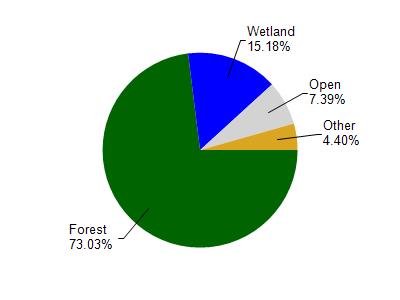Washburn
No
No
No
Fish and Aquatic Life
Overview
Twin Lake, North, in the Lower Namekagon River Watershed, is a 98.31 acre lake that falls in Washburn County. This lake is managed for fishing and swimming and is currently not considered impaired.
Date 2011
Author Aquatic Biologist
Historical Description
Source: 1978, Surface Water Resources of Washburn County
North Twin Lake, T41, 42N, R13W, Section 12, 35, 36, Surface Acres-113.0,
Maximum Depth-20 feet, M.P.A.-26 ppm, Secchi Disk-10 feet
A soft water, seepage lake in a chain of three lakes. They are
landlocked and have connecting boat channels with South Twin Lake and
Middle Lake. The fishery of North Twin Lake includes walleyes northern
pike, largemouth bass, slow-growing bluegills, black crappies,
pumpkinseeds, perch, bullheads, white suckers, common shiners, golden
shiners, and fathead minnows. Eighty-five percent of the lakeshore is
steeply sloped, but wooded with oak and jack pine. The littoral bottom
types are 95 percent sand and 5 percent muck off the small marsh bay at
the northeast end of the lake. Aquatic vegetation growth is moderate.
The lake is single-basined with a rather regular shape. The lake water
is clear. Its mean depth is six feet. A few mallards and teal nest
around the lake. Muskrats are present in fair numbers. There are 2
resorts and 17 cottages on the lakeshore. The Town of Chicog maintains
an access with a limited parking area on the lake's west end
near the channel to Middle Lake. The access site is the extent of
the public frontage here.
Date 1978
Author Surface Water Inventory Of Wisconsin
General Condition
North Twin Lake (2485900) was assessed during the 2016 listing cycle; total phosphorus and chlorophyll sample data were clearly below 2016 WisCALM listing thresholds for the Recreation use and Fish and Aquatic Life use. This water is meeting these designated uses and is not considered impaired.
Date 2015
Author Ashley Beranek
Condition
Wisconsin has over 84,000 miles of streams, 15,000 lakes and milllions of acres of wetlands. Assessing the condition of this vast amount of water is challenging. The state's water monitoring program uses a media-based, cross-program approach to analyze water condition. An updated monitoring strategy (2015-2020) is now available. Compliance with Clean Water Act fishable, swimmable standards are located in the Executive Summary of Water Condition in 2018. See also the 'monitoring and projects' tab.
Reports
Management Goals
Wisconsin's Water Quality Standards provide qualitative and quantitative goals for waters that are protective of Fishable, Swimmable conditions [Learn more]. Waters that do not meet water quality standards are considered impaired and restoration actions are planned and carried out until the water is once again fishable and swimmable
Management goals can include creation or implementation of a Total Maximum Daily Load analysis, a Nine Key Element Plan, or other restoration work, education and outreach and more. If specific recommendations exist for this water, they will be displayed below online.
Monitoring
Monitoring the condition of a river, stream, or lake includes gathering physical, chemical, biological, and habitat data. Comprehensive studies often gather all these parameters in great detail, while lighter assessment events will involve sampling physical, chemical and biological data such as macroinvertebrates. Aquatic macroinvertebrates and fish communities integrate watershed or catchment condition, providing great insight into overall ecosystem health. Chemical and habitat parameters tell researchers more about human induced problems including contaminated runoff, point source dischargers, or habitat issues that foster or limit the potential of aquatic communities to thrive in a given area. Wisconsin's Water Monitoring Strategy was recenty updated.
Grants and Management Projects
Monitoring Projects
| WBIC | Official Waterbody Name | Station ID | Station Name | Earliest Fieldwork Date | Latest Fieldwork Date | View Station | View Data |
|---|
| 2485900 | North Twin Lake | 663103 | North Twin Lake - Deep Hole | 8/17/1993 | 8/31/2025 | Map | Data |
| 2485900 | North Twin Lake | 10018262 | North Twin Lake -- Access | 10/19/2006 | 9/12/2025 | Map | Data |
| 2485900 | North Twin Lake | 10006945 | North Twin Lake | 4/28/1996 | 9/12/2017 | Map | Data |
|

Watershed Characteristics
North Twin Lake is located in the Lower Namekagon River watershed which is 239.34 mi². Land use in the watershed is primarily forest (73.10%), wetland (15.20%) and a mix of open (7.40%) and other uses (4.40%). This watershed has 172.53 stream miles, 12,590.30 lake acres and 21,781.64 wetland acres.
Nonpoint Source Characteristics
This watershed is ranked Not Ranked for runoff impacts on streams, Not Ranked for runoff impacts on lakes and Low for runoff impacts on groundwater and therefore has an overall rank of Low. This value can be used in ranking the watershed or individual waterbodies for grant funding under state and county programs.However, all waters are affected by diffuse pollutant sources regardless of initial water quality. Applications for specific runoff projects under state or county grant programs may be pursued. For more information, go to surface water program grants.